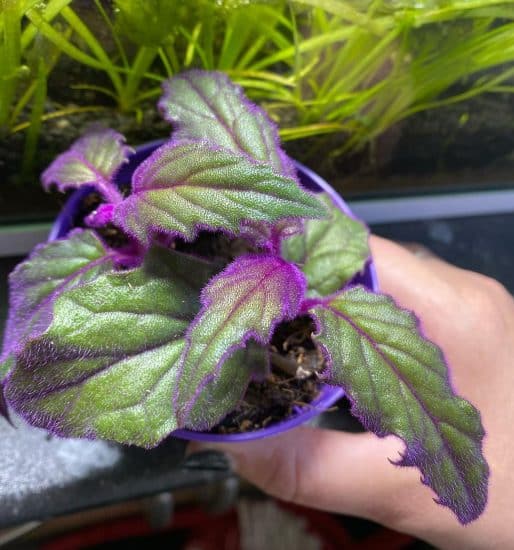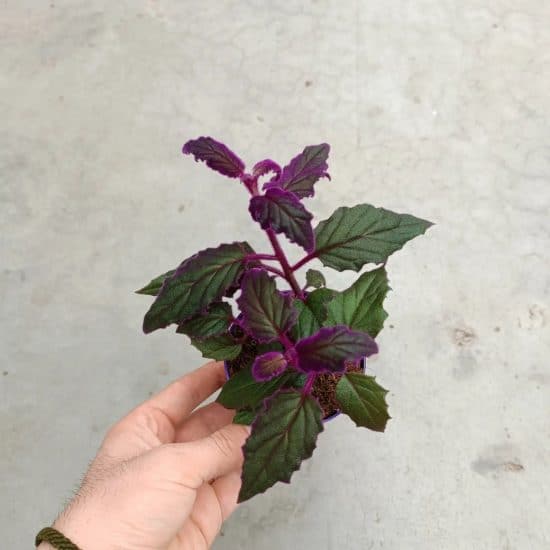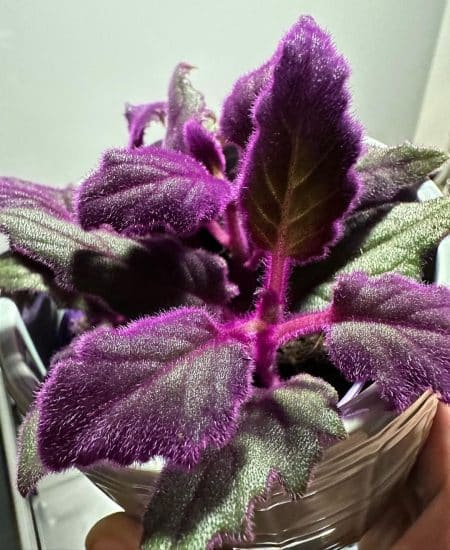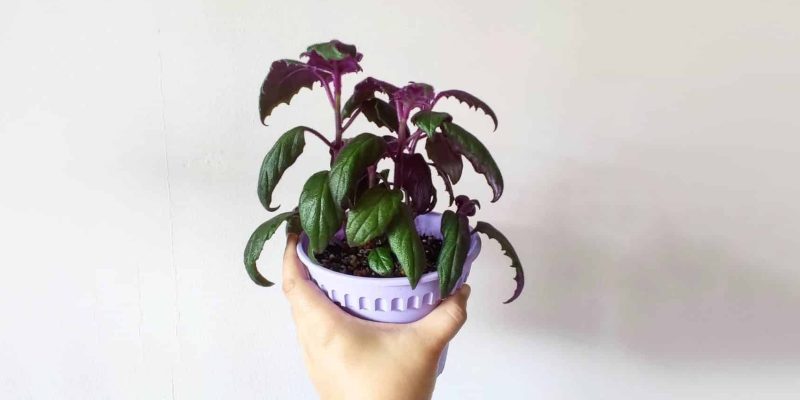Featuring rich velvety leaves with a striking purple hue and orange flowers, it’s no wonder the Purple Passion Plant has become a living staple of households around the world.
(It’s also known as the Purple Velvet Plant, but not the Purple People Eater).
Its trailing growth habit and vivid colors make it perfect for hanging baskets. Are you ready to add this fascinating pop of color to your indoor garden?
We’ll cover Purple Passion Plant care, providing you with all the tips and tricks you need to keep your vibrant new friend happy and healthy. From watering techniques to propagation tips, we’ve got you covered.
Table of Contents
Purple Passion Plant Care Guide
History, Habitat, and Characteristics

The Purple Passion Plant (Gynura aurantiaca) hails from Southeast Asia and is a member of the Asteraceae family, making it a relative of sunflowers. It’s even got orange flowers reminiscent of sunflowers, in color if not shape! (They can have an unpleasant smell, so feel free to remove them if you like).
Purple Passion Plant boasts tiny, soft purple hairs that cover its foliage and stems. These hairs provide the plant with a unique appearance and truly head-turning purple glow. As the plant ages, it reveals a subtle green metallic undertone with finer hairs.
(There is also a variegated variety with leaves that show off a mix of green, purple, and cream hues.)
Despite its lavish appearance, the Purple Velvet Plant isn’t too high maintenance. It does have a penchant for wild growth though, given its vine-like habit. A good pruning now and then will encourage a bushier appearance and prevent the plant from becoming leggy. After all, it’s important to keep up appearances!
Fun fact: In addition to being the life of the party, the Purple Passion Plant is believed to bring good luck in some Southeast Asian cultures. So not only will this plant dazzle your guests, it might just bring a little extra fortune your way!
Light

In its native habitat, the Gynura aurantiaca enjoys dappled sunlight filtered through taller plants. In an indoor setting, you can mimic these conditions for your Purple Passion Plant by placing it in a spot that receives bright, indirect light throughout the day.
If your Purple Passion Plant is experiencing too much sunlight, you might notice its leaves starting to fade, or developing sunburn and scorched spots. To fix this, move this tropical plant to an area with softer light (like indirect morning sun), or consider adding a sheer curtain to diffuse the hot direct sunlight of the afternoon.
On the flip side, a Purple Passion Plant that is not receiving enough light may show signs of slow, leggy growth, and lose some of its vibrant purple hues. To address this, try moving the plant to a brighter location or use an artificial light source, like an LED full-spectrum grow light.
Lighting tips:
- If you notice too much direct sunlight with damaged leaves, add a sheer curtain to block the direct sunlight, or even tuck your Gynura aurantiaca behind other houseplants.
- This plant’s fuzzy leaves love plenty of indirect sunlight. If you’re struggling with finding a good location with sufficient indirect light, consider a hanging basket or adding an artificial LED grow light.
- The bright light of afternoon sun can be a bit hot, so always match sun exposure and temperature with your watering frequency.
Water

The Purple Passion Plant thrives with a consistent watering schedule that keeps its soil evenly moist. Each time you water your Purple Passion Plant, do so slowly and thoroughly. Allow the water to soak in and ensure that it’s properly draining through (and out of) the container.
Not enough water can result in wilting or curling leaves, along with the loss of the vibrant purple color that many gardeners appreciate. It may also cause the plant to struggle as it starts growing. To remedy this, gradually increase your watering frequency and remove any dead or dying leaves (to prevent potential pests from feasting on them).
Too much water often leads to yellowing leaves, and even mold or decay if the soil stays wet for too long — a common issue in many houseplants. If you suspect your plant is getting too much water, let the soil dry out a bit and adjust your routine accordingly.
Temperature and Humidity

Your Purple Passion Plants appreciate an ideal temperature range of 60-75°F. Avoid exposing the plant to sudden temperature fluctuations or cold drafts, as this may cause stress and damage its delicate foliage. Pay attention to your watering habits during cooler temperatures to prevent overwatering and root rot.
Signs of temperature stress for Gynura aurantiaca include wilting or drooping leaves if it’s too warm, and leaf curling and discoloration if it’s too cold.
Purple Passion Plants favor moderate humidity levels of around 40-60%. It’s important to maintain moisture around the plant without directly wetting its foliage, however. Misting the leaves could cause fungal and bacterial growth, as their soft purple hairs can trap moisture.
If the humidity is too low, you may observe brown or crispy leaf tips, whereas mold or fungus on the leaves is likely due to excessive humidity.
To raise humidity:
- Use a pebble tray under your Purple Passion Plant to boost the surrounding humidity.
- Position a humidifier nearby.
- Group Purple Passion Plants with other tropical houseplants that also enjoy moderate humidity, creating a shared, moist microclimate.
- Place the plant in a naturally humid area (like a bathroom) to provide extra moisture.
Soil and Planting

The ideal soil mix for the Purple Passion Plant starts with a base of high-quality, general purpose potting mix. Add organic matter like compost, well-rotted manure, or peat moss. This organic component will help retain moisture and provide essential nutrients for your plant’s growth.
Perlite is another important ingredient for your soil mix, since it improves aeration and drainage. By adding perlite, you can prevent rot and maintain a healthy root system for your Purple Passion Plant, ensuring the appropriate balance of air and water around its roots.
When it’s time to repot your plant, transfer the entire root ball without disturbing the roots too much. Make sure the new pot has drainage holes and consider placing a screen (a coffee filter will do the trick!) at the bottom to prevent soil spillage.
Aim to repot during the spring, when the plant is less stressed and more likely to thrive in its new environment.
Fertilizer
The Purple Passion Plant will do well with a half-strength all-purpose fertilizer applied in the spring. Follow the label instructions to avoid over-fertilizing.
Signs of too much fertilizer include yellowing leaves and weak or spindly growth. If you notice these symptoms, cut back on fertilization and flush the soil with water to remove excess nutrients.
Propagation

Propagating Purple Passion Plants (whoa, alliteration!) is super easy, and it can be an exciting process for both beginners and experts alike. In this guide, we’ll be using stem cuttings, and we’ll walk you through each step so you can create lovely new plants in no time. Ready to dive in?
Propagate Purple Passion Plant via stem cuttings:
- Choose a stem: First, find a healthy stem on your Purple Passion Plant, ideally around 4-6 inches long with a few leaves on it. Then, use clean and sterilized scissors or pruning shears to make the cut.
- Prepare the cutting: Next, remove the bottom leaves from the lower part of the cutting, being sure to leave 2-3 leaves on the top. This helps prevent rotting when you propagate cuttings in water or soil.
- Soil propagation: To try soil propagation, all you need to do is stick the cut end of the stem into moist soil. You can use a small plastic cup for this, but be sure to poke drainage holes in the bottom first. Then, place it in a spot with direct morning sun, and water it regularly to ensure it stays consistently moist.
- Water propagation: If you’d rather propagate cuttings in water, fill a small container with filtered water and place the stem cutting in it. Keep the leaves out of the water and find a spot for it that gets bright but indirect sunlight. Change the water every 2-3 days. In a few weeks, you should see new roots forming!
- Time to transplant: When the roots are around 2 inches long, it’s time to move your new Purple Passion Plant to its permanent home — a suitably sized pot with well-draining soil and drainage holes on the bottom. Continue to keep the soil moist, and place your new plant in a spot with bright, indirect sunlight.
Our propagation tips:
- Use clean, sterilized shears when taking cuttings from Purple Velvet Plants to prevent infections.
- Keep the soil consistently moist for your new plants, but be careful not to overwater and risk root rot.
- Aim to take your stem cutting during the growing season, like late spring or early summer, for the best results.
Common Issues

Caring for Purple Passion Plants is relatively straightforward, but occasionally, they can experience some common issues. Don’t worry — we’re here to guide you through identifying these problems and provide practical solutions to help your plant flourish.
Uneven Growth
One issue you may come across with your Purple Passion Plant is uneven growth. This typically happens when the plant doesn’t receive consistent light exposure, causing it to stretch towards the light source. This esults in longer, thinner stem sections with less dense foliage.
To promote even growth, make sure all sides of your Purple Passion Plants have equal access to light. Rotate the plant regularly, and if necessary, prune back leggy stems to encourage a fuller and more balanced growth pattern.
Be cautious of too much sunlight, as it may lead to damaged leaves. With these steps, you’ll help your Purple Passion Plant grow more uniformly and beautifully.
Brown, Crispy Leaf Tips
Another common issue to look out for is brown, crispy leaf tips, cupped leaves, or dull, lackluster foliage. This can occur if your Purple Passion Plant is underwatered or when the humidity is too low.
To remedy this situation, ensure you’re keeping your soil consistently moist. If the top inch of the soil feels dry, it’s time for a drink. Also check that the surrounding microclimate isn’t too dry.
If necessary, increase the humidity by using a pebble tray or humidifier, or group your Purple Passion Plant together with other tropical plants.
Pests and Diseases

Like many other indoor plants, your Purple Passion Plant may occasionally face challenges related to common pests and diseases.
Root Rot
Does your Purple Passion Plant have wilting leaves, black or brown spots, and mushy, slimy roots? You might be dealing with root rot. This issue often occurs when the plant is overwatered or has poor drainage. To prevent it, make sure your plant is potted in well-draining soil with adequate drainage holes.
If root rot strikes, it’s time for action. Carefully remove your Purple Passion Plant from its pot and cut away any affected roots. Then, repot the plant in fresh soil that drains well, and prevent overwatering in the future by letting the soil dry out a bit more between waterings.
Fungal infections
A damp environment can invite fungal diseases to your Purple Passion Plant, which might show up as white, circular patches on the leaves or stems. To avoid these unwanted guests, always keep the leaves dry and avoid overwatering. You can also try wiping the leaves down with a cloth regularly — fungi hate cleanliness!
If you do spot signs of a fungal infection, take action by isolating the Purple Passion Plant (this helps protect your other indoor plants). Remove all affected leaves and stems, then treat the plant with a fungicide spray.
Pests

Mealybugs, scale insects, and spider mites are some pesky little hitchhikers that might take a liking to your Purple Passion Plant. Keep a watchful eye for signs like small white bugs, webbing under the leaves, and general plant decline.
If you discover any of these signs, act fast! First things first — isolate the plant. Grab a damp cloth to wipe off any visible pests from the leaves and stems. For severe infestations, we recommend using neem oil for almost every pest. Just follow the directions on the label (they can be different dilutions) and reapply in 2-3 weeks.
For a Purple Passion Vine with spider mites, you’ll want to also increase the local humidity and routinely spray and gently wipe down the leaves with water.
Stay vigilant and regularly inspect your plant for any returning pests, treating them as necessary. Your Purple Passion Plant will be pest-free in no time!
Conclusion

And that wraps up our Purple Passion Plant care and growing guide!
Whether you call it the Purple Velvet Plant, a purple passion vine, or its botanical name of Gynura aurantiaca, you should know everything you need to take care of this tropical plant.
The Purple Passion Plant is a beautiful indoor plant that never fails to attract attention and admiration. Despite its bold appearance, this houseplant is relatively low maintenance, making it a perfect addition to any indoor garden.
Purple Velvet Plant care summary:
- Provide bright, indirect light to maintain the vibrant purple leaves of the velvet plant, and rotate it regularly for even growth.
- Water thoroughly and consistently to ensure consistently moist soil while avoiding overwatering.
- Maintain moderate temperature and humidity levels, ensuring your velvet plant isn’t exposed to sudden temperature fluctuations or drafts.
- Use an appropriate soil mix consisting of organic matter, perlite, and a high-quality potting mix to ensure proper drainage and aeration.
- Fertilize your Purple Passion Plant during the growing season with a half-strength all-purpose fertilizer, following label instructions carefully.
- Repot and propagate as needed to maintain a healthy and stunning plant.
We hope this guide has been helpful! If you found it valuable, feel free to share it with friends or on your favorite social media platform. If you have any questions or need further guidance, reach out — we’re happy to help.
Enjoy your vibrant Purple Passion Plant, and happy gardening!
FAQ
How do you encourage Purple Velvet Plant flowers?
If you want to see those orange blooms, give your plant lots of light and fertilize it in the growing months (spring and summer). If your Purple Velvet Plant isn’t getting enough light to produce flowers, try supplementing with LED grow lights.
Can Purple Passion Plants be planted outdoors?
Yes! You can plant this beauty outdoors, but because of the sun, older growth might have a more faded, less vibrant purple hue. It likes medium to bright light outside, and soil that’s moist but not sopping. (If you forget to water it every so often, it won’t die).


